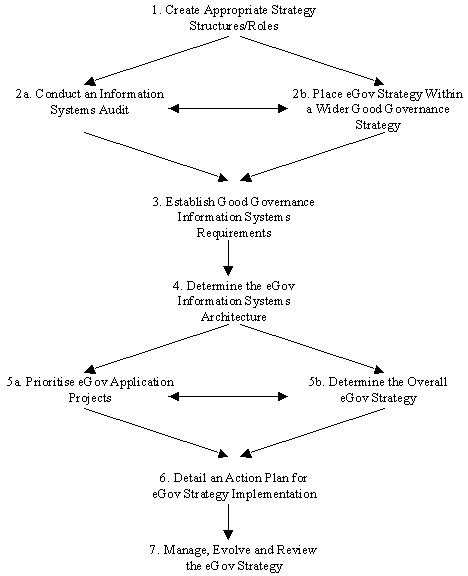In the Techniques section:
Techniques
Avoiding eGov Failure: Ideas About Overall Vision/Strategy
This page offers ideas about how to address one factor identified as important to the success or failure of e-government projects. Follow this link for more information about such factors (and some related case examples).
Idea 1: Undertake a Structured eGovernment Strategy Exercise
The diagram below summarises a step-by-step approach to the creation of e-government strategy.

An example of a strategic approach can be found at::
http://www.ogc.gov.uk/sdtoolkit/deliveryteam/strategy/index.html (UK-focused)
Examples of such e-gov strategies in industrialised countries can be found via:
http://www.lgov.org/library_frames.html
(From: Richard Heeks)
Idea 2: Ensure Your eGov Strategy has a Sound Underlying Architecture
To create a building, you need a sound underlying architecture for that building, based on an architect's plan. The same is true for e-government. The 'architecture' for e-government consists of five elements:
- · Data architecture: an overall plan for the data items (and their relationships) necessary to deliver e-government.
- · Process architecture: a plan of the key activities that e-government will support and undertake.
- · Technology architecture: how computers will be sized and connected for e-government, and an outline of the software to be used.
- · Data management architecture: how data input, processing, storage and output functions will be divided across the information technology architecture.
- · Management architecture: the policies, standards, human resource systems, management structures, financial systems, etc. necessary to support e-government.
(From: Richard Heeks & Alan Mitchell)
Idea 3: Create a Single High-Level Strategic Body
This body - of senior staff and other powerful stakeholders - can take responsibility for functions such as scoping and commissioning an e-government strategy; prioritising particular e-government projects; ensuring necessary resources are in place to deliver projects; and monitoring progress in e-government.
Where such a body is set up with a view across the whole of government, it can also have a coordination function - ensuring some degree of inter-operability between independently-developed e-government applications, assisting reusability of solutions to avoid 'reinventing the wheel', and generally facilitating learning across e-government projects.
(From: R.M. Bhatt & Neki Frasheri)
Idea 4: Don't Let Strategy Become Detached From Local Realities
In an overall sense, e-government strategy asks three questions:
- "Where are we now?" (Here)
- "Where do we want to get to?" (There)
- "How do we get from here to there?"
The danger is that asking such questions ignores local realities, creating a hypothetical vision of "There" that can never be achieved. Government is only one player: rather than thinking it can design its environment, it should instead design TO its environment. This means infusing question 1 with a sense of where clients (e.g. local citizens, local businesses, local communities, local NGOs, local agencies) currently are: their current rates of ICT access and use; their current needs; their current priorities. It means infusing question 2 with a true sense of where those clients are headed: forecast trends in ICTs, needs, priorities, etc. By doing this, you create a realistic rather than idealistic e-government strategy.
Where e-government strategy does not take the local environment into account, problems will arise. In one Central African nation, for example, there was an ambitious strategy for e-government. However, this strategy failed to take account of local realities: funding limitations, infrastructural constraints, mismatch with objectives of key players, problems of theft of equipment. The result was a failed strategy. In some Indian states, too, e-government strategy has been a top-down, techno-centric exercise that neglects the social, economic and cultural realities of intended client groups. Such strategies are self-defeating disasters.
Another way of putting all this is to say that e-government strategy designs must take good account of existing realities. Follow this link for more material on identifying and closing design-reality gaps.
(From: Horace Mitchell, Olivier Kenhago & Dipankar Sinha)
Idea 5: Set Clear "Go/No Go" Criteria
Thinking in a high-level, strategic manner, work out a set of criteria for decision-making about e-government projects. What criteria will you use to decide whether or not an e-government project should be supported and funded? What criteria will you use to decide that a project - once funded - will be abandoned?
(From: Horace Mitchell)
Idea 6: Make Your eGovernment Vision Clear, Collective, Challenging and Customised
A good e-government strategy will have the following features. It will be clear: ordinary citizens will understand what it seeks to achieve. It will be collective: shared by the key stakeholders involved (and probably developed collectively in order to meet that criterion). It will be challenging: not so optimistic as to be unrealistic, not so pessimistic as to be uninspiring: one watchword is "Think Big, Start Small, Scale Fast". It will be customised: matched to specific local conditions.
(From: Olivier Nana Nzepa & Sameer Sachdeva)
Idea 7: The Objectives of eGovernment Strategy Should be Better Government
In one or two states in India, for example, e-government is seen as the servant of broader good governance objectives. Put another way, e-government is seen as a means, not as an end in itself. The end specified in some cases is SMART government: government that is simple, moral, accountable, responsive and transparent.
(From: Sameer Sachdeva)
Idea 8: Do Something
Don't become so wrapped up in visions and strategies that you never actually do anything. And don't let strategy-making be an excuse for inaction. Small, useful e-government projects can proceed alongside strategy, and can create knowledge that feeds into strategy-making.
(From: Lishan Adam)